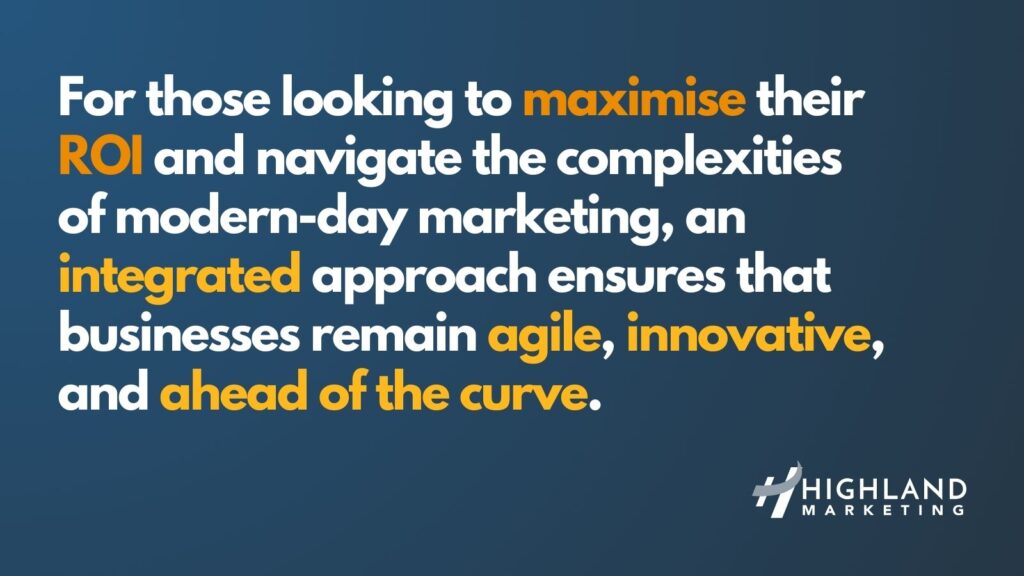Collaboration is the name of the game. A report by the World Federation of Advertisers (WFA), 74% of global brands are now working in tandem with in-house teams and an external marketing agency to achieve cohesive campaigns.
This article explores how businesses can harmoniously blend the deep brand understanding of in-house teams with the diverse expertise of an external marketing agency, offering insights into effective budgeting for the upcoming year.
The allure of in-house marketing
Having an in-house marketing team can offer a range of benefits, from a deep understanding of the brand to quick decision-making processes.
Deep brand understanding
An in-house team lives and breathes the brand daily. This intimate knowledge can lead to more authentic and consistent messaging across all marketing channels.
Quick decision-making and adaptability
With all team members under one roof, decisions can be made swiftly. This agility can be especially beneficial in crisis situations or when capitalising on timely opportunities.
Cost considerations
While setting up an in-house team can be costly initially, in the long run, it might prove to be more cost-effective, especially for larger companies that have extensive and continuous marketing needs.
The case for an external marketing agency
On the flip side, an external marketing agency bring a fresh perspective, a wide range of expertise, and can often be more scalable.
Diverse expertise at your fingertips
A marketing agency will often have a broad range of experts, from SEO specialists to graphic designers. This diversity can bring a richness to marketing campaigns that might be challenging to achieve in-house.
Fresh, unbiased perspective
An external marketing agency can view a brand from the outside, offering fresh insights and innovative strategies that an in-house team might overlook.
Scalability and flexibility
For businesses with fluctuating needs, a marketing agency can offer scalability. Whether it’s ramping up efforts for a new product launch or scaling down in off-peak seasons, agencies can adjust swiftly.
Budgeting for in-house vs. outsourced
As 2024 approaches, businesses need to evaluate their marketing needs and budget accordingly. Both in-house teams and external agencies come with their own set of costs.
Initial setup vs. recurring costs
While in-house teams might require a significant initial investment in terms of recruitment, training, and infrastructure, their costs can be more predictable in the long run. On the other hand, a marketing agency might have recurring costs based on the scope of work, but without the initial setup expenses.
Evaluating ROI
Understanding the return on investment is crucial. Tools like Highland Marketing’s analysing markets can offer insights into the effectiveness of marketing campaigns, helping businesses make informed budgeting decisions.
The synergy of collaboration
The fusion of in-house and outsourced marketing isn’t just a trend; it’s a strategic move that many businesses are adopting. Let’s delve deeper into the reasons behind this synergy and how it’s shaping the future of marketing.
Bridging the knowledge gap
While in-house teams possess an intrinsic understanding of the brand, an external marketing agency bring a wealth of experience from working with diverse clients. This combination ensures that marketing strategies are both brand-centric and enriched with external insights.
Access to specialised tools and technologies
An external marketing agency will often have access to the latest marketing tools and technologies. By collaborating, in-house teams can leverage these resources, ensuring campaigns are more efficient and data-driven. Platforms like Highland Marketing’s sales acceleration tools can be seamlessly integrated, offering advanced analytics and insights.
Cost-effective scalability
One of the significant advantages of this collaborative approach is scalability. Businesses can scale their marketing efforts up or down based on needs, without the constraints of fixed in-house resources.
Continuous learning and development
With the constant exchange of ideas and strategies, both in-house teams and agency professionals benefit from continuous learning. This mutual growth ensures that marketing strategies remain innovative and up-to-date.
Streamlined communication
Contrary to the belief that working with an external marketing agency might lead to communication barriers, many businesses find that a collaborative approach fosters clearer communication. With defined roles and responsibilities, there’s less room for ambiguity.
Crafting a balanced budget
As we’ve established the benefits of a collaborative approach, the next challenge is budgeting. How can businesses allocate funds effectively to ensure both in-house and external resources are utilised optimally?
Assessing core competencies
It’s essential to evaluate the core competencies of the in-house team. If the team excels in content creation but lacks in SEO expertise, it makes sense to allocate funds for an external SEO agency.
Setting clear objectives
Before diving into budget allocation, businesses must set clear marketing objectives. Whether it’s brand awareness, lead generation, or customer retention, having clear goals ensures funds are channelled effectively.
Monitoring and adjusting
Budgeting isn’t a one-time activity. With services like those provided by Highland Marketing’s analysing markets, businesses can monitor campaign performance and adjust budgets accordingly, ensuring maximum ROI.

Striking the perfect balance
Achieving harmony between in-house and outsourced marketing is akin to orchestrating a symphony. Each component, while powerful on its own, can create magic when in sync with the other. Here’s how businesses can strike that perfect balance.
Embracing a culture of collaboration
The first step is fostering a culture where both in-house and agency teams view each other as partners, not competitors. Regular brainstorming sessions, workshops, and joint training can help in building this collaborative spirit.
Defining roles and responsibilities
Clarity is crucial. By clearly defining the roles and responsibilities of each team, businesses can avoid overlaps and ensure that every aspect of the marketing strategy is covered.
Leveraging strengths
It’s essential to recognise and leverage the strengths of both teams. If the in-house team excels in content creation, let them lead that front. Conversely, if the marketing agency brings superior data analytics skills, they should handle that domain.
Open channels of communication
Ensuring open and transparent communication is key. Regular check-ins, feedback sessions, and progress reports can help in keeping everyone on the same page.
Adapting and evolving
The world of marketing is ever-evolving. Businesses should be open to adapting their strategies based on feedback from both teams. This adaptability ensures that the marketing approach remains relevant and effective.
Measuring success and ROI
With the collaborative approach in place, the next step is measuring its success.
Setting KPIs
Key Performance Indicators (KPIs) should be set at the outset. These could range from website traffic and lead generation to customer engagement metrics.
Regular reviews
Periodic reviews using tools like Highland Marketing’s telling stories can offer insights into campaign performance, helping businesses understand what’s working and what needs tweaking.
Celebrating successes
Every milestone, big or small, should be celebrated. Recognising the efforts of both teams fosters a positive working environment and motivates teams to strive for more.
The future is collaborative
As we step into 2024, the future of marketing is undeniably collaborative. By harnessing the strengths of both in-house and external marketing agency, businesses can craft holistic marketing strategies that resonate with their audience. And as the landscape continues to evolve, this integrated approach ensures that businesses remain agile, innovative, and ahead of the curve. For those looking to maximise their ROI and navigate the complexities of modern-day marketing, Highland Marketing stands ready to guide and support. Embrace the future, and let’s craft marketing magic together.


